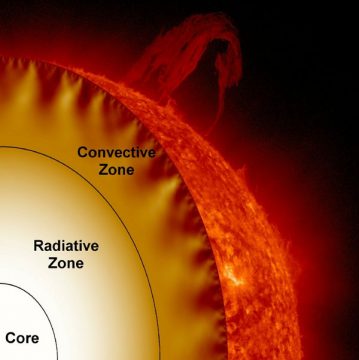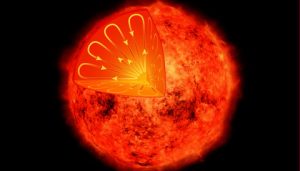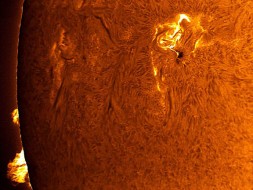.
Observations confirm that the closest star to our solar system has a regular magnetic cycle similar to our Sun.
With the recent discovery of a potentially habitable planet around Proxima Centauri, astronomers have been studying this star with renewed fervor. Part of their attention focuses on the star’s behavior. M dwarfs are notorious for their flares, and such stellar tantrums could be deadly for budding life on nearby planets.
But it’s only the young M dwarfs that are truly “flare stars.” Proxima Centauri, on the other hand, is roughly 5 billion years old (we think), and although it certainly flares, we’re not sure what its long-term activity is at such a respectable age. One thing astronomers thought they knew, though, was that such stars wouldn’t have regular magnetic cycles like we see on the Sun. Our star goes through an 11-year sunspot cycle as its global field flips directions, but that shouldn’t happen on little stars like Proxima.
Or so we thought. Now both observations and computer simulations confirm that, contrary to expectation, Proxima Centauri and stars like it do have regular magnetic cycles.
Why the Sun Flips Its Poles Every 11 Years

The solar interior is separated into three main regions. Energy is generated in the core, the innermost 25%. This energy diffuses outward by radiation (mostly gamma rays and X-rays) through the radiative zone, but by the boiling motion of convective fluid flows through the convection zone, which makes up the outermost third of the Sun. Between the radiative and convective zones lies a thin interface layer called the tachocline. It's here that the Sun's magnetic field is generated.
NASA / MSFC
The Sun has what’s called a dipolar magnetic field — basically, a big bar magnet with a north and south pole. Every 11 years, the field flips on its head. It’s a regular, (mostly) dependable activity cycle, with sunspots — the places where the star’s churning plasma tangles the magnetic field — growing in number as the cycle reaches its peak, presaging the flip.
Scientists think magnetic fields of this sort arise between two zones in the Sun: an inner radiative zone just outside the core, where energy is carried outward by radiation (hence the name) and which rotates like a solid ball; and the outer convective zone, where the “boiling” motion of plasma carries energy to the surface. The convective zone rotates differentially, which means that stuff at the Sun’s equator rotates faster than stuff at its poles. Because of differential rotation, the convective layer slides across the radiative layer at different speeds in different places, stirring up the plasma. Plasma is hot, ionized gas, so when its charged particles move they create a magnetic field — in this case, one that’s coherent on a global scale because that’s the scale at which this differential rotation is happening.
But stars smaller than about 35% the Sun’s mass — including Proxima Centauri — are convective the whole way through. Thus they shouldn’t have dependable magnetic cycles. That’s not to say they won’t have magnetic activity at all; these stars can be marred with giant starspots and unleash countless flares. They just won’t have a regularly flip-flopping field.
That’s the idea, anyway. Astronomers have turned up some M dwarfs with activity cycles, however. And with the increasing attention being paid to these stellar runts as great places to look for planets, researchers want to know just what they’re really doing.
A Cycle for Proxima Centauri

The lowest-mass stars, including Proxima Centauri, are "fully convective": they transfer energy from their cores to their surfaces via the conveyor-belt-like motion of convection. More massive stars, including the Sun, only have a convective envelope; for the Sun, it's the outermost third of the star. Stars like the Sun have different magnetic activity cycles thanks to the shearing effect between the convective envelope and the zone below. Astronomers thought the lowest-mass stars wouldn't have regular activity cycles, but observations now confirm that the nearby star Proxima Centauri shows signs of a 7-year activity cycle.
NASA / CXC /M.Weiss
Previous observations have explored whether Proxima Centauri has an activity cycle, with some suggesting that it does. Inspired by an article he saw about one of these studies in 2007 in Sky & Telescope, Bradford Wargelin (Harvard-Smithsonian Center for Astrophysics) decided to investigate whether hints of a cycle were real. (At the time he didn’t buy it.)
Wargelin and his colleagues amassed optical, ultraviolet, and X-ray observations of the star from ground- and space-based telescopes, spanning 22 years. The UV and X-ray photons generally come from flares, and cyclic variations at these wavelengths are a lot more obvious than those in optical. The team found that, yep, Proxima Centauri has a 7-year cycle, with the X-rays and UV going up when the optical brightness goes down — as would be expected if the star is plastered in starspots (dimming its optical brightness) during times of heightened activity. The 7-year cycle agrees well with previous studies that narrowed in on a 7- to 8-year range. (Incidentally, the study mentioned in S&T argued for a 1.2-year cycle, which Wargelin's team disproved.)
Reporting October 8th in Monthly Notices of the Royal Astronomical Society, the team also detected evidence of differential rotation. That’s very interesting, because it’s differential rotation that’s ultimately responsible for the Sun’s cyclic activity.
To understand what may be going on, we need to turn to computer simulations. Rakesh Yadav (also Harvard-Smithsonian Center for Astrophysics) and others have been working on what happens inside M dwarfs and how they create their magnetic fields. The astronomers’ most recent work agrees that slow-spinning M dwarfs like Proxima Centauri, which rotates about every 83 days, do have differential rotation and magnetic cycles. Fast rotators, on the other hand, have neither.
It all comes down to how well the magnetic field controls the star. Quickly spinning stars are generally young, with very strong magnetic fields created by the churning plasma. These magnetic fields essentially hold the star’s plasma rigidly in place as it rotates, preventing differential rotation, Yadav explains. No differential rotation means no flip-flopping field: the team does not see activity cycles in their simulations of fast-rotating, fully convective M dwarfs. The stars do have very strong magnetic fields, but they’re frozen in place, never flipping. Chaotic convection near the surface “shreds” the global field, creating small-scale activity that powers flares.
Conversely, the simulations show that as a star slows down, its global magnetic field weakens. Such a field can’t hold the plasma hostage anymore, and the equator can break away from the poles, spinning faster. The differential rotation creates widespread shears inside the convecting star and, thus, a coherent field that flip-flops regularly.
Yadav’s team estimates in their latest paper, posted to the online preprint server arXiv.org on October 9th, that a star with properties like Proxima’s would have a cycle of 9 years — very close to the observed 7-year cycle. Although its field is weaker than a young M dwarf’s, it’s still a few hundred times stronger than the Sun’s.
If the simulations are capturing what’s really happening in these stars, we should not see activity cycles on young, fast-rotating M dwarfs, but we should on older, slower ones. It’ll take dedicated effort and years of observations to reveal whether that’s the case. Astronomers are already making headway on that: recent work by Alejandro Suárez Mascareño (Astrophysics Institute of the Canary Islands, Spain) and others has turned up cycles in several M dwarfs.
Quelle: Sky&Telescope

